DODGE TRUCK 1993 Service Repair Manual
Manufacturer: DODGE, Model Year: 1993, Model line: TRUCK, Model: DODGE TRUCK 1993Pages: 1502, PDF Size: 80.97 MB
Page 601 of 1502
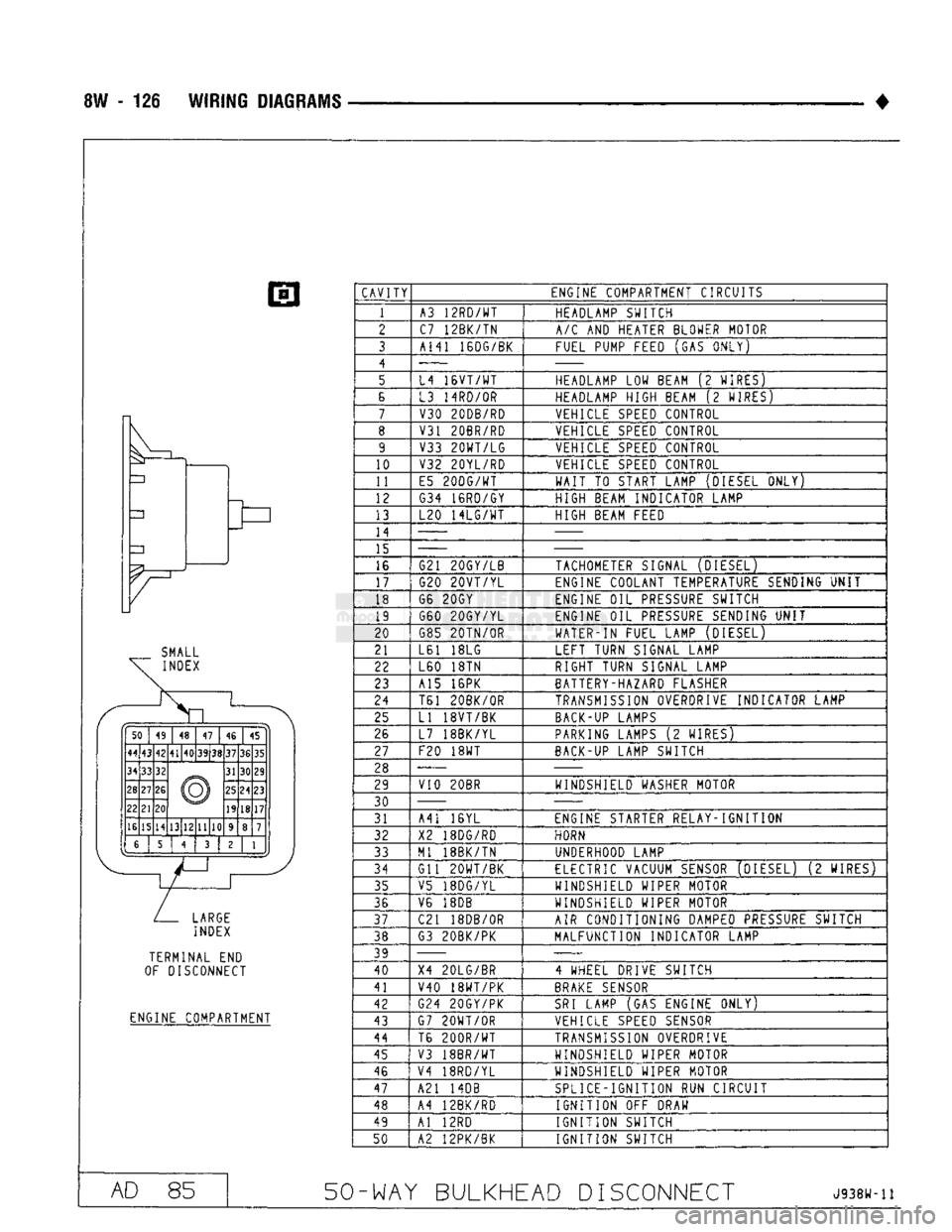
8W - 126
WIRING
DIAGRAMS
SMALL
INDEX
50 49 48
47
46 45
44 43 42 41
40 39
38 37
36 35
34 33 32
© 31
30 29
28 27
26
© 25
24 23
22 21
20 ©
19 18
17
16 15 14 13 12 11 10 9 8 7
6 5 4
3 2
1
LARGE
INDEX TERMINAL END
OF DISCONNECT
ENGINE COMPARTMENT CAVITY
1
10
11
12
13
14 15
16
17
18 19
20
21
22
23
24
25
26
27
28
29
30 31
32 33
34
35
36
37
38
39 40
41
42
43
44
45
46
47
48
50 ENGINE COMPARTMENT CIRCUITS
A3 12RD/WT C7 12BK/TN
A141 16DG/BK
L4
16VT/WT
L3 14RD/0R
V30 20DB/RD
V31 20BR/RD V33
20WT/LG
V32 20YL/RD
E5
20DG/WT
G34 16RD/GY
L20
14LG/WT
G21 20GY/LB G20
20VT/YL
G6 20GY
G60 20GY/YL
G85 20TN/OR
L61 18LG L60 18TN
A15 16PK
T61 20BK/0R
LI 18VT/BK
L7 18BK/YL
F20 18WT
V10 20BR
A41 16YL
X2 18DG/RD
Ml 18BK/TN
Gil
20WT/BK
V5 18DG/YL
V6 18DB
C21 18DB/0R
G3 20BK/PK
X4 20LG/BR V40 18WT/PK
G24 20GY/PK
G7 2GWT/0R T6
200R/WT
V3 18BR/WT
V4 18RD/YL
A21 14DB
A4 12BK/RD Al 12RD
A2 12PK/BK HEADLAMP SWITCH
A/C
AND HEATER BLOWER MOTOR
FUEL PUMP FEED (GAS ONLY)
HEADLAMP LOW BEAM (2 WIRES)
HEADLAMP HIGH BEAM (2 WIRES)
VEHICLE
SPEED
CONTROL
VEHICLE
SPEED
CONTROL VEHICLE
SPEED
CONTROL
VEHICLE
SPEED
CONTROL
WAIT
TO START LAMP (DIESEL
QNLYr
HIGH BEAM INDICATOR LAMP
HIGH BEAM FEED
TACHOMETER SIGNAL (DIESEL)
ENGINE COOLANT TEMPERATURE SENDING
UNIT
ENGINE OIL
PRESSURE
SWITCH
ENGINE OIL
PRESSURE
SENDING
UNIT
WATER-IN FUEL LAMP (DIESEL)
LEFT TURN SIGNAL LAMP RIGHT TURN SIGNAL LAMP
BATTERY-HAZARD FLASHER
TRANSMISSION
OVERDRIVE INDICATOR LAMP
BACK-UP LAMPS
PARKING LAMPS (2 WIRES)
BACK-UP LAMP SWITCH
WINDSHIELD WASHER MOTOR
ENGINE STARTER RELAY
-1GNITI
ON HORN
UNDERHOOD LAMP
ELECTRIC
VACUUM
SENSOR
(DIESEL) (2 WIRES)
WINDSHIELD WIPER MOTOR
WINDSHIELD WIPER MOTOR
AIR CONDITIONING DAMPED
PRESSURE
SWITCH
MALFUNCTION INDICATOR LAMP
4 WHEEL DRIVE SWITCH
BRAKE
SENSOR
SRI
LAMP (GAS ENGINE ONLY)
VEHICLE
SPEED SENSOR
TRANSMISSION
OVERDRIVE
WINDSHIELD WIPER MOTOR
WINDSHIELD WIPER MOTOR
SPLICE-IGNITION RUN CIRCUIT
IGNITION
OFF DRAW
IGNITION
SWITCH
IGNITION
SWITCH
AD 85 50-WAY BULKHEAD DISCONNECT
J938W-11
Page 602 of 1502
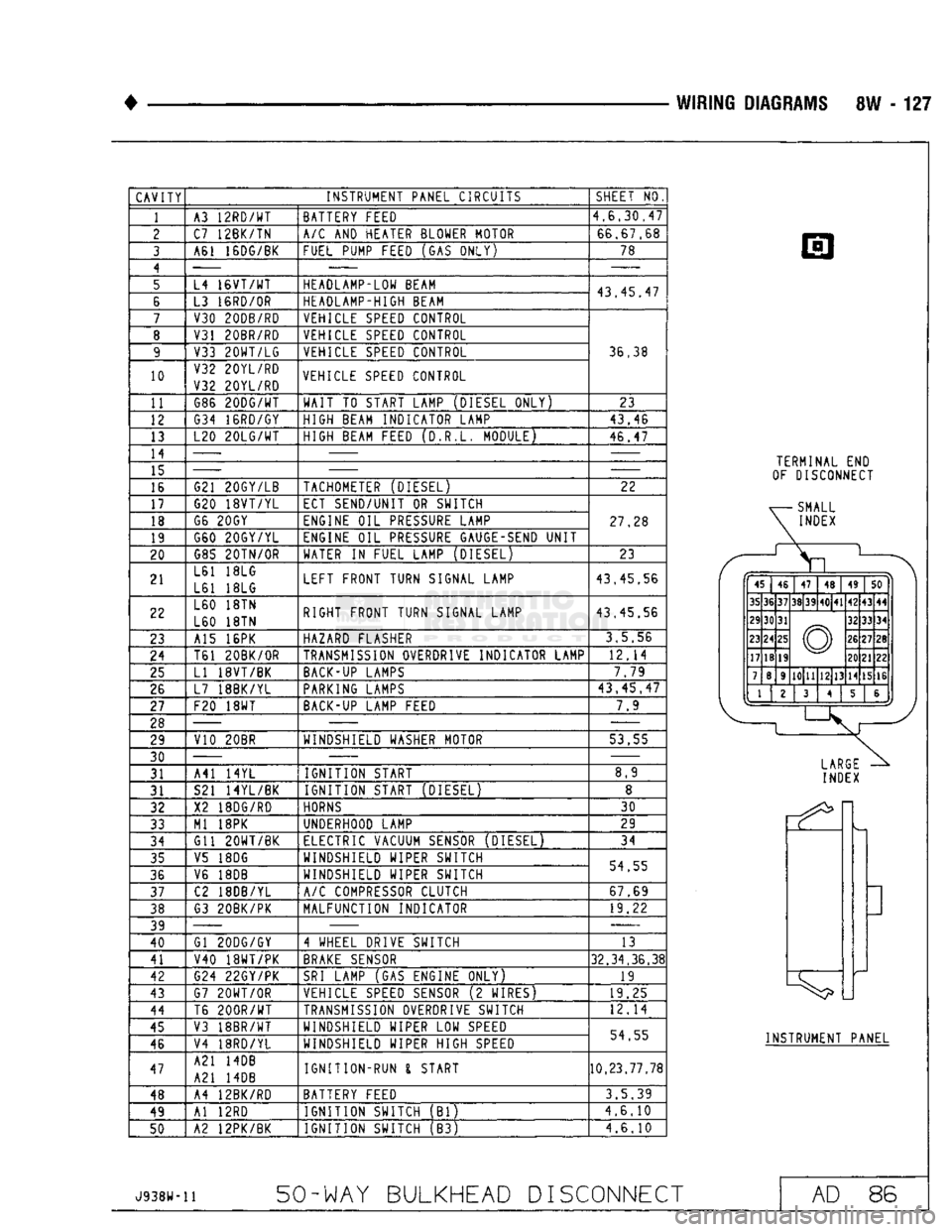
•
WIRING
DIAGRAMS
8W - 127
CAVITY
INSTRUMENT PANEL CIRCUITS
1
10
11
12
13
14
15
16
17
18
19
20
21
22
23
24
25
26
27
28 29
30 31
31
32
33
34
35
36
37
38
39
40
41
42
43
44
45
46
47
48
49
50
A3
12RD/WT
C7 12BK/TN
A61 16DG/BK
L4
16VT/WT
L3
16RD/0R
V30 20DB/RD
V31 20BR/RD
V33
20WT/LG
V32 20YL/RD
V32 20YL/RD G86
20DG/WT
G34 16RD/GY
L20
20LG/WT
G21 20GY/LB
G20
18VT/YL
G6
20GY
G60 20GY/YL G85
20TN/0R
L61
18LG
L61
18LG
L60
18TN
L60
18TN
A15
16PK
T61 20BK/OR
LI
18VT/BK
L7 18BK/YL
F20
18WT
V10 20BR
A41
14YL
S21 14YL/BK
X2
18DG/R0
Ml
18PK
Gil
20WT/BK
V5
18DG
V6
18DB
C2 18DB/YL
G3 20BK/PK
Gl 20DG/GY
V40
18WT/PK
G24 22GY/PK
G7
20WT/0R
T6
200R/WT
V3 18BR/WT
V4 18RD/YL
A21
14DB
A21
14DB
A4 12BK/RD
Al
12RD
A2 12PK/BK BATTERY FEED
A/C
AND
HEATER BLOWER MOTOR
FUEL PUMP FEED
(GAS
ONLY)
HEADLAMP-LOW BEAM
HEADLAMP-HIGH BEAM VEHICLE
SPEED
CONTROL
VEHICLE
SPEED
CONTROL VEHICLE
SPEED
CONTROL
VEHICLE
SPEED
CONTROL
WAIT
TO
START LAMP (DIESEL ONLY)
HIGH BEAM INDICATOR LAMP
HIGH BEAM FEED (D.R.L. MODULE)
TACHOMETER (DIESEL)
ECT SEND/UNIT
OR
SWITCH
ENGINE
OIL
PRESSURE
LAMP
ENGINE
OIL
PRESSURE
GAUGE-SEND
UNIT
WATER
IN
FUEL LAMP (DIESEL)
LEFT FRONT TURN SIGNAL LAMP
RIGHT FRONT TURN SIGNAL LAMP
HAZARD FLASHER
TRANSMISSION
OVERDRIVE INDICATOR LAMP
BACK-UP
LAMPS
PARKING
LAMPS
BACK-UP
LAMP FEED
WINDSHIELD WASHER MOTOR
IGNITION START
IGNITION START (DIESEL)
HORNS
UNDERHOOD LAMP
ELECTRIC VACUUM
SENSOR
(DIESEL) WINDSHIELD WIPER SWITCH
WINDSHIELD WIPER SWITCH
A/C
COMPRESSOR CLUTCH
MALFUNCTION INDICATOR
4 WHEEL DRIVE SWITCH
BRAKE
SENSOR
SRI
LAMP
(GAS
ENGINE ONLY)
VEHICLE
SPEED
SENSOR
(2
WIRES)
TRANSMISSION
OVERDRIVE SWITCH
WINDSHIELD WIPER
LOW
SPEED
WINDSHIELD WIPER HIGH
SPEED
IGNITION-RUN
I
START
BATTERY FEED IGNITION SWITCH
(Bl)
IGNITION SWITCH
(B3)
SHEET
NO
4,6.30,47
66,67,68 78
43,45,47
36,38
23
43,46
46,47
22
27,28
23
43.45,56
43,45.56
3,5,56
12,14 7.79
43,45,47
7.9
53.55 8,9
30
29
34
54,55 67,69 19,22
13
32,34,36,38
19
19,25
12,14
54.55
10,23.77,78
3.5.39
4,6.10
4.6.10
TERMINAL
END
OF DISCONNECT
ff
p
45 46
47
48 49
50
35 36 37
38 39
40 41
42
43 44
29 30 31
© 32
33 34
23 24
25
© 26
27 28
17 18
19 ©
20 21 22
7 8 9
10 11
12 13
14 15 16
1
^
1.
2
3
4 5 &
J *j
LARGE
INDEX
INSTRUMENT PANEL
J938W-11
50-WAY BULKHEAD
DISCONNECT
AD
86
Page 603 of 1502
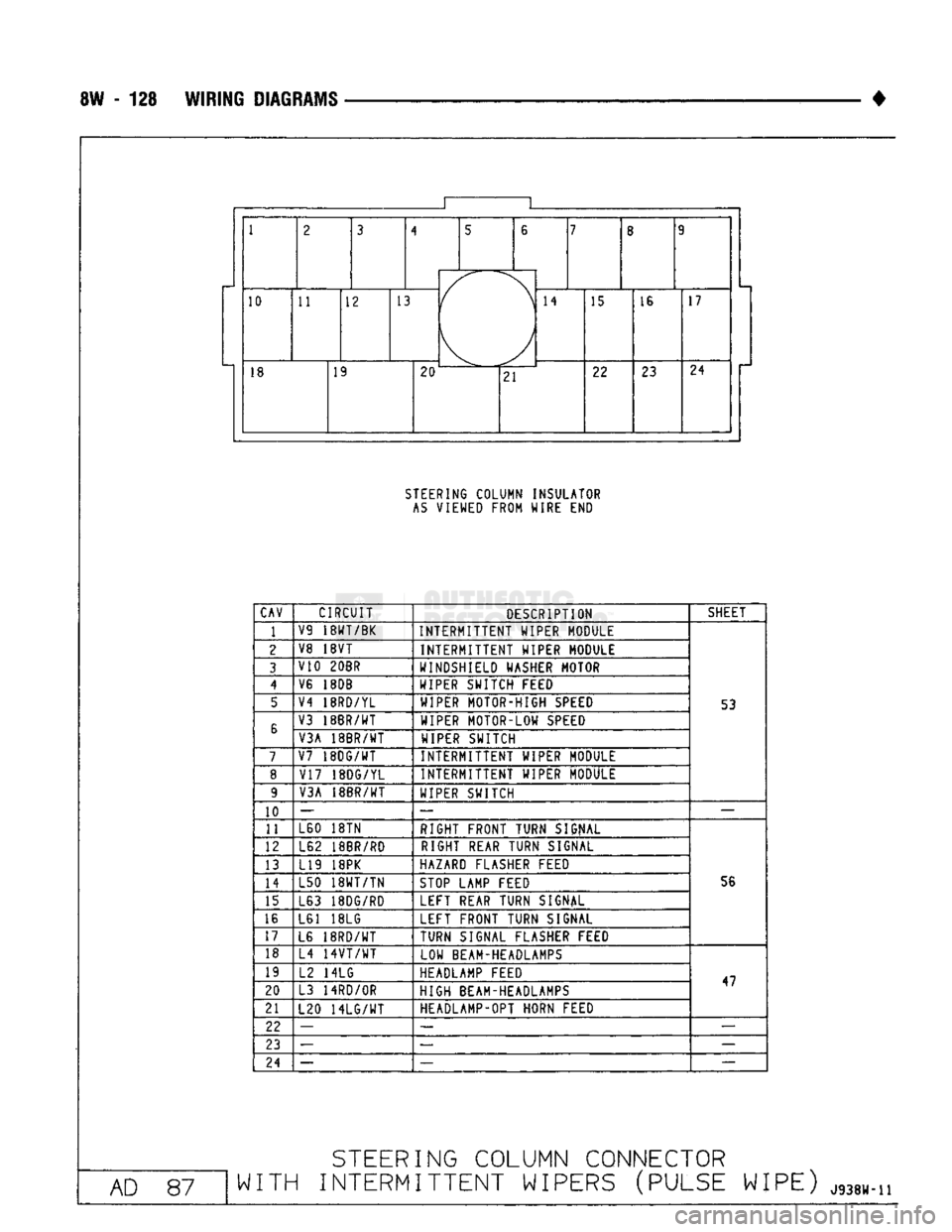
8W - 128 WIRING
DIAGRAMS
• 10
11 12
13
14
15 16 17
18 19
20
21 22
23 24
STEERING
COLUMN INSULATOR
AS
VIEWED FROM WIRE END
CAV
CIRCUIT
DESCRIPTION SHEET
1
V9
18WT/BK
INTERMITTENT WIPER MODULE
2 V8 18VT
INTERMITTENT WIPER MODULE
3 V10 20BR
WINDSHIELD WASHER MOTOR
4 V6 18DB
WIPER SWITCH FEED
5 V4 18RD/YL
WIPER MOTOR-HIGH SPEED
53
6 V3 18BR/WT
WIPER MOTOR-LOW SPEED
6
V3A 18BR/WT WIPER SWITCH
7 V7
18DG/WT
INTERMITTENT WIPER MODULE
8
V17 18DG/YL INTERMITTENT WIPER MODULE
9 V3A 18BR/WT
WIPER SWITCH
10 —
— —
11 L60 18TN
RIGHT FRONT TURN SIGNAL
12 L62 18BR/RD RIGHT REAR TURN SIGNAL
13 L19 18PK HAZARD FLASHER FEED
14 L50
18WT/TN
STOP LAMP FEED 56
15 L63 18DG/RD LEFT REAR TURN SIGNAL
16 L61 18LG LEFT FRONT TURN SIGNAL
17 L6
18RD/WT
TURN SIGNAL FLASHER FEED
18 L4
14VT/WT
LOW BEAM-HEADLAMPS
19 L2 14LG HEADLAMP FEED
47
20 L3
14RD/0R
HIGH BEAM-HEADLAMPS 47
21 L20
14LG/WT
HEADLAMP-OPT HORN FEED
22 —
— —
23 —
—
24 — —-
—
AD
87
STEERING
COLUMN CONNECTOR
WITH
INTERMITTENT WIPERS (PULSE WIPE)
J938W.n
Page 604 of 1502
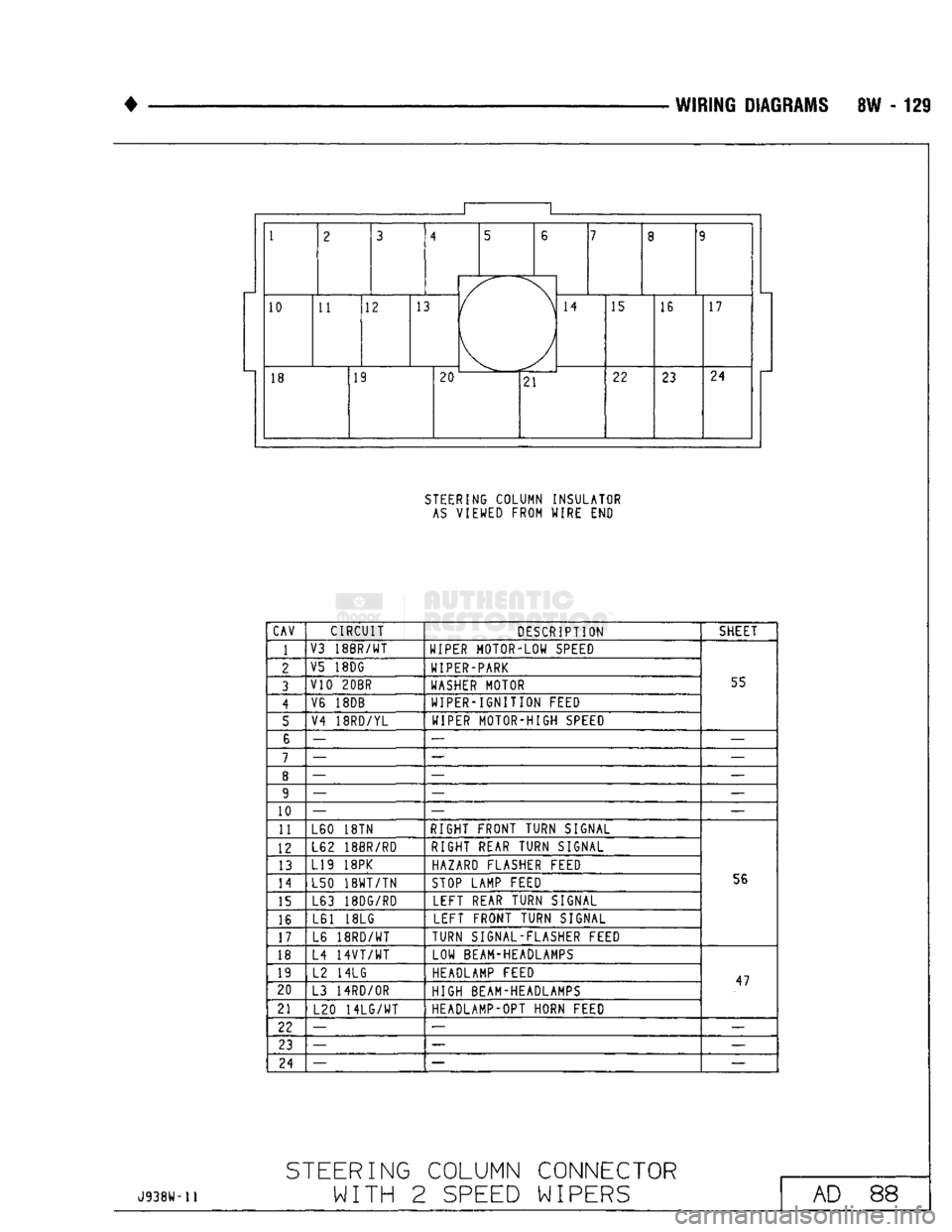
•
WIRING DIAGRAMS 8W - 129 1
1
2 3
4 5
6
7
8 9
1
2 3
(
\ ) 7
8 9
10 11 12 13
(
\ ) 14
15 16 17
18 19
20 ^-— -
21 22
23 24
STEERING COLUMN INSULATOR
AS
VIEWED FROM WIRE END
CAV CIRCUIT
DESCRIPTION SHEET
1
V3
18BR/WT
WIPER MOTOR-LOW SPEED
55
2
V5 18DG
WIPER-PARK
55
3 V10
20BR
WASHER MOTOR 55
4 V6 18DB
WIPER-IGNITION FEED 55
5 V4
18RD/YL
WIPER MOTOR-HIGH SPEED 55
6 —
— —
7 —
— —
8 —
— —
9 —
— —
10 —
— —
11 L60 18TN
RIGHT FRONT TURN SIGNAL
56
12
L62 18BR/RD
RIGHT REAR TURN SIGNAL
56
13
L19 18PK
HAZARD FLASHER FEED
56
14 L50
18WT/TN
STOP LAMP FEED 56
15 L63 18DG/RD
LEFT REAR TURN SIGNAL 56
16 L61 18LG
LEFT FRONT TURN SIGNAL 56
17 L6
18RD/WT
TURN SIGNAL-FLASHER FEED 56
18 L4
14VT/WT
LOW BEAM-HEADLAMPS
47
19
L2 14LG HEADLAMP FEED
47
20 L3 14RD/OR
HIGH BEAM-HEADLAMPS 47
21 L20
14LG/WT
HEADLAMP-OPT HORN FEED 47
22 —
— —
23 —
— —
24 —
—
—
J938H-11
STEERING
COLUMN CONNECTOR
WITH 2
SPEED
WIPERS
AD 88
Page 605 of 1502
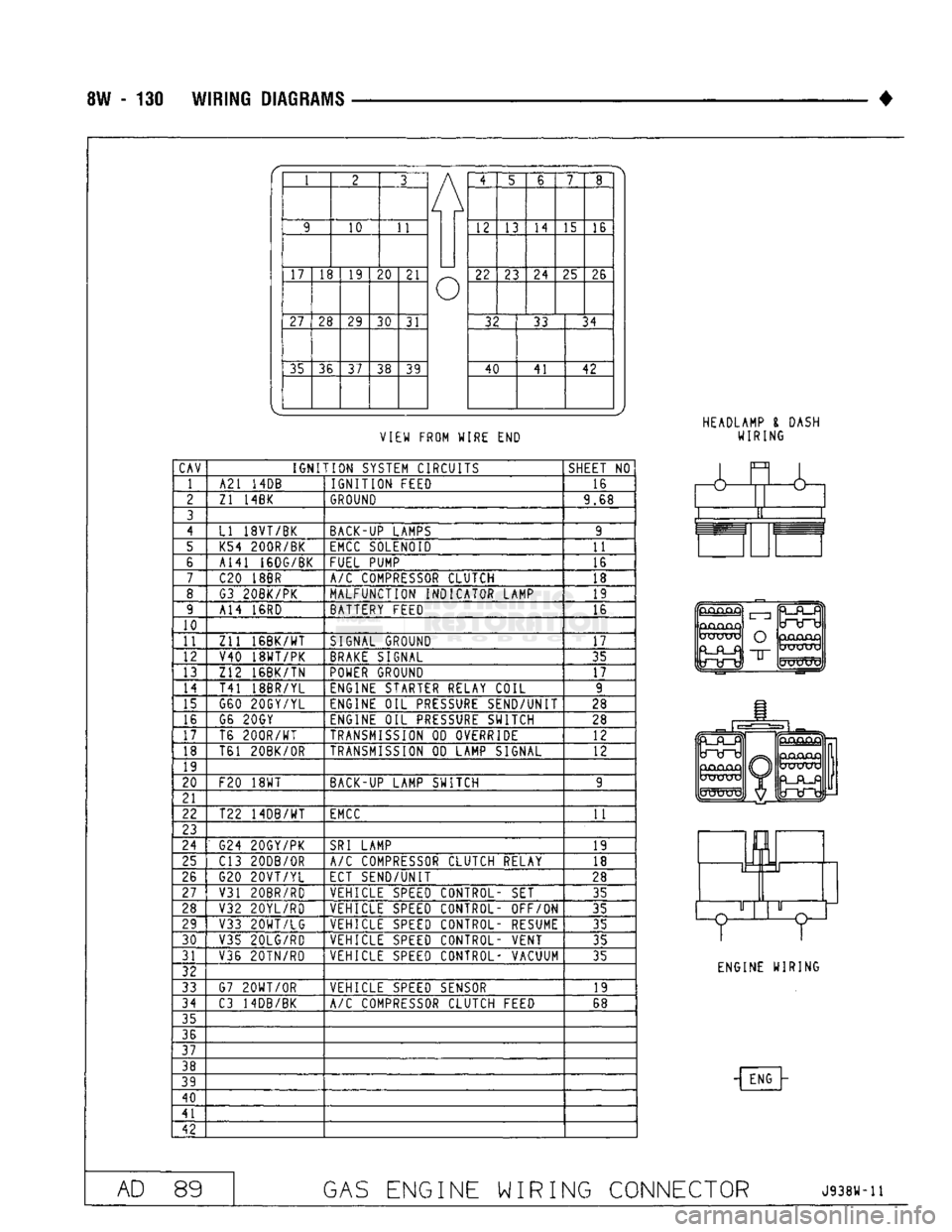
8W - 130
WIRING
DIAGRAMS
•
1 2 3
A 4
5 6
7
8
/
9
10
11
/
12 13
14
15 16
/
17
18
19
20
21
u
22
23
24
25 26
u
27
28 29
30
31
u
32 33
34
u
35 36
37
38 39
u
40
41 42
u
VIEW FROM WIRE
END
HEADLAMP
I
DASH
WIRING
CAV
IGNITION
SYSTEM CIRCUITS
SHEET
NO
1 A21
14DB
IGNITION
FEED 16
2
Zl 14BK
GROUND
9.68
3
4
LI 18VT/BK BACK-UP LAMPS 9
5 K54 200R/BK
EMCC
SOLENOID
11
6 A141 16DG/BK
FUEL PUMP 16
7
C20
18BR
A/C
COMPRESSOR CLUTCH 18
8 G3 20BK/PK MALFUNCTION INDICATOR LAMP 19
9 A14
16RD
BATTERY FEED 16
10
11
Zll
16BK/WT
SIGNAL GROUND
17
12 V40 18WT/PK
BRAKE
SIGNAL 35
13 Z12 16BK/TN
POWER
GROUND
17
14
T41 18BR/YL ENGINE STARTER RELAY COIL 9
15 G60 20GY/YL ENGINE
OIL
PRESSURE
SEND/UNIT 28
16 G6 20GY
ENGINE
OIL
PRESSURE
SWITCH 28
17 T6
200R/WT
TRANSMISSION
OD
OVERRIDE 12
18 T61 20BK/0R
TRANSMISSION
OD
LAMP SIGNAL
12
19
20
F20
18WT
BACK-UP LAMP SWITCH 9
21
22 T22 14DB/WT
EMCC
11
23
24
G24 20GY/PK
SRI
LAMP
19
25 C13 20DB/0R
A/C
COMPRESSOR CLUTCH RELAY
18
26 G20
20VT/YL
ECT SEND/UNIT
28
27
V31 20BR/RD VEHICLE
SPEED
CONTROL-
SET
35
28 V32 20YL/RD VEHICLE
SPEED
CONTROL- OFF/ON
35
29 V33
20WT/LG
VEHICLE
SPEED
CONTROL- RESUME 35
30
V35 20LG/RD VEHICLE
SPEED
CONTROL- VENT
35
31 V36 20TN/RD VEHICLE
SPEED
CONTROL- VACUUM
35
32
33 G7
20WT/0R
VEHICLE
SPEED
SENSOR 19
34
C3 14DB/BK
A/C
COMPRESSOR CLUTCH FEED 68
35
36
37
38
39
40
41
42
&
GjCUQjQ
UXJUXj
O
"IT
mJKXTV
ENGINE WIRING
- ENG
AD
89
GAS
ENGINE WIRING CONNECTOR
J938W-11
Page 606 of 1502
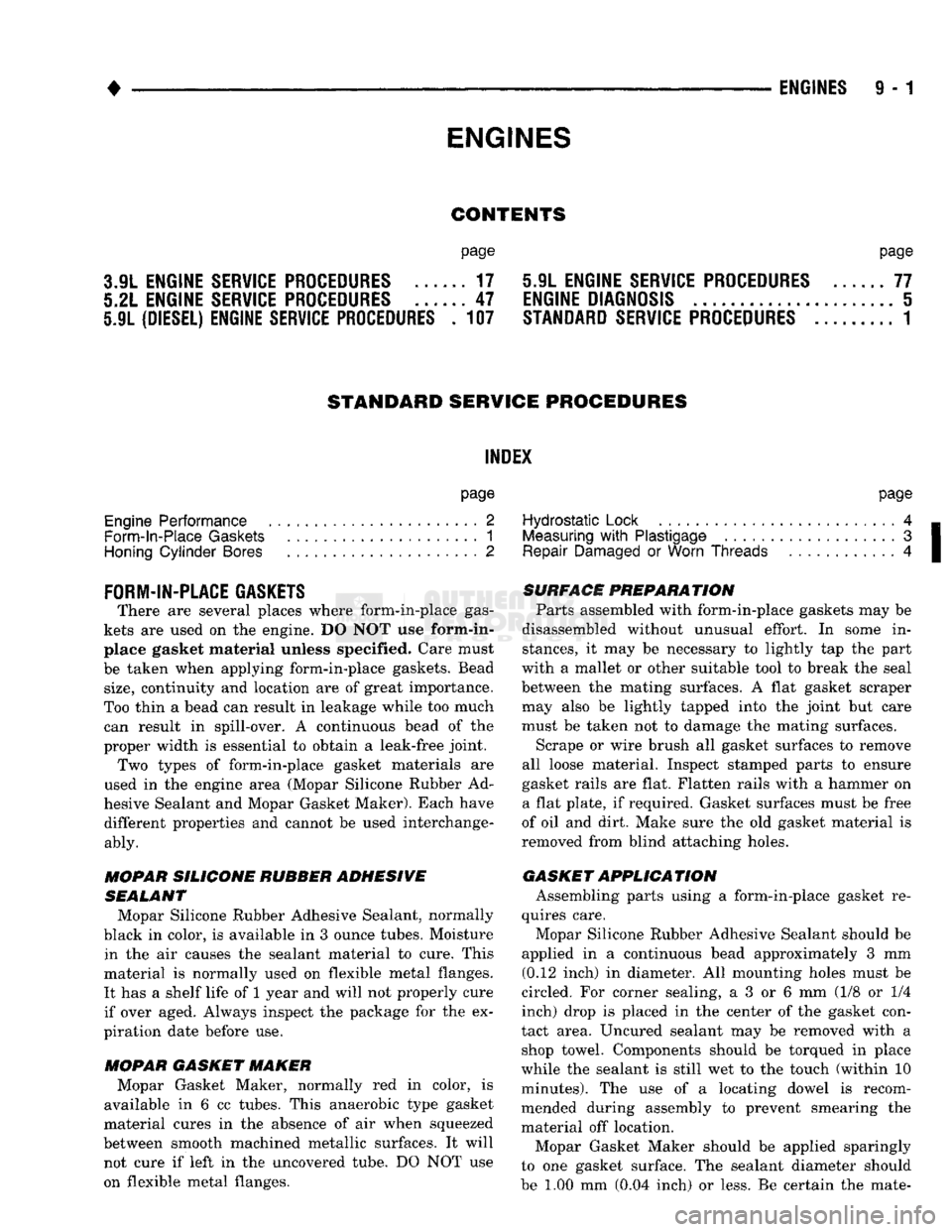
•
ENGINES ENGINES
9 - 1
CONTENTS
page page
3.9L
ENGINE SERVICE PROCEDURES
17 5.9L
ENGINE SERVICE PROCEDURES
77
5.2L
ENGINE SERVICE PROCEDURES
47
ENGINE DIAGNOSIS
5
5.9L
(DIESEL) ENGINE SERVICE PROCEDURES
. 107
STANDARD SERVICE PROCEDURES
1
STANDARD SERVICE PROCEDURES INDEX
page
Engine
Performance 2
Form-ln-Place
Gaskets
1
Honing
Cylinder
Bores
2
FORM-IN-PLACE GASKETS
There are several places where form-in-place gas
kets are used on the engine. DO NOT use form-in-
place gasket material unless specified. Care must
be taken when applying form-in-place gaskets. Bead
size,
continuity and location are of great importance.
Too thin a bead can result in leakage while too much can result in spill-over. A continuous bead of the
proper width is essential to obtain a leak-free joint. Two types of form-in-place gasket materials are
used in the engine area (Mopar Silicone Rubber Ad
hesive Sealant and Mopar Gasket Maker). Each have different properties and cannot be used interchange ably.
MOPAR SILICONE RUBBER ADHESIWE
SEALANT
Mopar Silicone Rubber Adhesive Sealant, normally
black in color, is available in 3 ounce tubes. Moisture in the air causes the sealant material to cure. This
material is normally used on flexible metal flanges.
It has a shelf life of 1 year and will not properly cure
if over aged. Always inspect the package for the ex
piration date before use.
MOPAR
GASKET MAKER Mopar Gasket Maker, normally red in color, is
available in 6 cc tubes. This anaerobic type gasket
material cures in the absence of air when squeezed
between smooth machined metallic surfaces. It will not cure if left in the uncovered tube. DO NOT use on flexible metal flanges.
page
Hydrostatic
Lock
4
Measuring
with
Plastigage 3
Repair
Damaged
or Worn
Threads
. 4
SURFACE PREPARA
TION
Parts assembled with form-in-place gaskets may be
disassembled without unusual effort. In some in
stances, it may be necessary to lightly tap the part
with a mallet or other suitable tool to break the seal
between the mating surfaces. A flat gasket scraper may also be lightly tapped into the joint but care
must be taken not to damage the mating surfaces.
Scrape or wire brush all gasket surfaces to remove
all loose material. Inspect stamped parts to ensure
gasket rails are flat. Flatten rails with a hammer on a flat plate, if required. Gasket surfaces must be free
of oil and dirt. Make sure the old gasket material is
removed from blind attaching holes.
GASKET
APPLICATION
Assembling parts using a form-in-place gasket re
quires care.
Mopar Silicone Rubber Adhesive Sealant should be
applied in a continuous bead approximately 3 mm (0.12 inch) in diameter. All mounting holes must be
circled. For corner sealing, a 3 or 6 mm (1/8 or 1/4
inch) drop is placed in the center of the gasket con
tact area. Uncured sealant may be removed with a shop towel. Components should be torqued in place
while the sealant is still wet to the touch (within 10
minutes). The use of a locating dowel is recom
mended during assembly to prevent smearing the
material off location.
Mopar Gasket Maker should be applied sparingly
to one gasket surface. The sealant diameter should
be 1.Q0 mm (0.04 inch) or less. Be certain the mate-
Page 607 of 1502
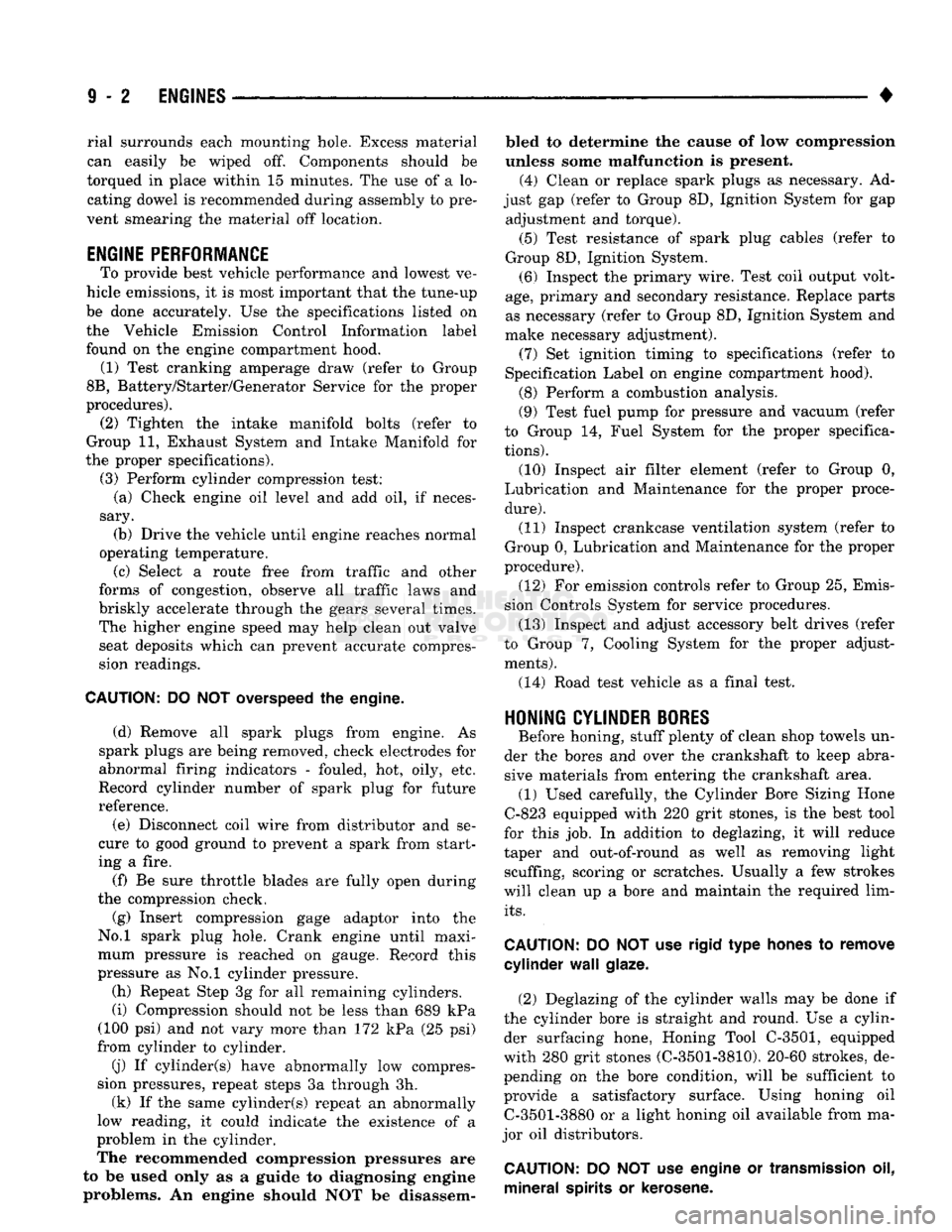
9
- 2
ENGINES
rial surrounds each mounting hole. Excess material
can easily be wiped off. Components should be
torqued in place within 15 minutes. The use of a lo cating dowel is recommended during assembly to pre
vent smearing the material off location.
ENGINE PERFORMANCE
To provide best vehicle performance and lowest ve
hicle emissions, it is most important that the tune-up
be done accurately. Use the specifications listed on
the Vehicle Emission Control Information label found on the engine compartment hood.
(1) Test cranking amperage draw (refer to Group
8B,
Battery/Starter/Generator Service for the proper
procedures).
(2) Tighten the intake manifold bolts (refer to
Group 11, Exhaust System and Intake Manifold for
the proper specifications). (3) Perform cylinder compression test:
(a) Check engine oil level and add oil, if neces
sary.
(b) Drive the vehicle until engine reaches normal
operating temperature. (c) Select a route free from traffic and other
forms of congestion, observe all traffic laws and
briskly accelerate through the gears several times. The higher engine speed may help clean out valve seat deposits which can prevent accurate compres
sion readings.
CAUTION:
DO NOT
overspeed
the
engine.
(d) Remove all spark plugs from engine. As
spark plugs are being removed, check electrodes for
abnormal firing indicators - fouled, hot, oily, etc.
Record cylinder number of spark plug for future
reference.
(e) Disconnect coil wire from distributor and se
cure to good ground to prevent a spark from start
ing a fire.
(f) Be sure throttle blades are fully open during
the compression check. (g) Insert compression gage adaptor into the
No.l spark plug hole. Crank engine until maxi
mum pressure is reached on gauge. Record this
pressure as No.l cylinder pressure.
(h) Repeat Step 3g for all remaining cylinders.
(i) Compression should not be less than 689 kPa
(100 psi) and not vary more than 172 kPa (25 psi)
from cylinder to cylinder.
(j) If cylinder(s) have abnormally low compres
sion pressures, repeat steps 3a through 3h. (k) If the same cylinder(s) repeat an abnormally
low reading, it could indicate the existence of a
problem in the cylinder.
The recommended compression pressures are
to be used only as a guide to diagnosing engine
problems. An engine should NOT be disassem bled to determine the cause of low compression
unless some malfunction is present. (4) Clean or replace spark plugs as necessary. Ad
just gap (refer to Group 8D, Ignition System for gap adjustment and torque).
(5) Test resistance of spark plug cables (refer to
Group 8D, Ignition System.
(6) Inspect the primary wire. Test coil output volt
age,
primary and secondary resistance. Replace parts as necessary (refer to Group 8D, Ignition System and
make necessary adjustment).
(7) Set ignition timing to specifications (refer to
Specification Label on engine compartment hood).
(8) Perform a combustion analysis.
(9) Test fuel pump for pressure and vacuum (refer
to Group 14, Fuel System for the proper specifica
tions).
(10) Inspect air filter element (refer to Group 0,
Lubrication and Maintenance for the proper proce
dure).
(11) Inspect crankcase ventilation system (refer to
Group 0, Lubrication and Maintenance for the proper
procedure).
(12) For emission controls refer to Group 25, Emis
sion Controls System for service procedures.
(13) Inspect and adjust accessory belt drives (refer
to Group 7, Cooling System for the proper adjust
ments).
(14) Road test vehicle as a final test.
H0NIN6
CYLINDER
BORES
Before honing, stuff plenty of clean shop towels un
der the bores and over the crankshaft to keep abra sive materials from entering the crankshaft area.
(1) Used carefully, the Cylinder Bore Sizing Hone
C-823 equipped with 220 grit stones, is the best tool
for this job. In addition to deglazing, it will reduce
taper and out-of-round as well as removing light scuffing, scoring or scratches. Usually a few strokes
will clean up a bore and maintain the required lim
its.
CAUTION:
DO NOT use rigid type
hones
to remove
cylinder
wall
glaze.
(2) Deglazing of the cylinder walls may be done if
the cylinder bore is straight and round. Use a cylin
der surfacing hone, Honing Tool C-3501, equipped
with 280 grit stones (C-3501-3810). 20-60 strokes, de
pending on the bore condition, will be sufficient to
provide a satisfactory surface. Using honing oil C-3501-3880 or a light honing oil available from ma
jor oil distributors.
CAUTION:
DO NOT use engine or
transmission
oil, mineral
spirits
or
kerosene.
Page 608 of 1502
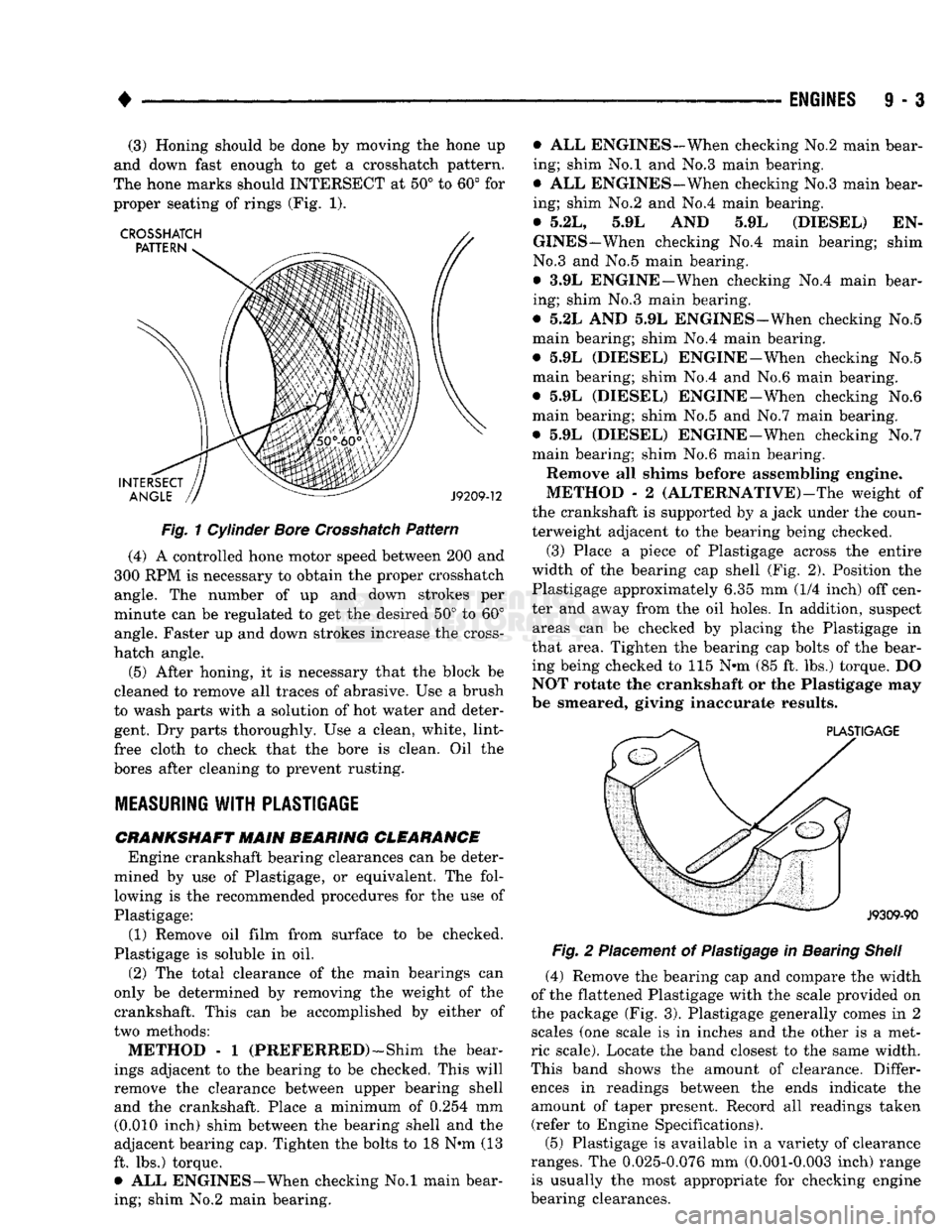
•
ENGINES
9 - 3
(3) Honing
should be
done
by moving the
hone
up
and down
fast
enough
to get a Crosshatch pattern.
The hone
marks should
INTERSECT
at 50° to 60° for
proper seating
of
rings (Fig.
1).
Fig.
1
Cylinder
Bore
Crosshatch
Pattern
(4)
A
controlled hone motor speed between
200 and
300
RPM is
necessary
to
obtain
the
proper Crosshatch angle.
The
number
of up and
down strokes
per
minute
can be
regulated
to get the
desired
50° to 60°
angle. Faster
up and
down strokes increase
the
cross-
hatch angle.
(5) After honing,
it is
necessary that
the
block
be
cleaned
to
remove
all
traces
of
abrasive.
Use a
brush
to wash parts with
a
solution
of hot
water
and
deter gent.
Dry
parts thoroughly.
Use a
clean, white, lint-
free cloth
to
check that
the
bore
is
clean.
Oil the
bores after cleaning
to
prevent rusting.
MEASURING
WITH
PLASTIGAGE
CRANKSHAFT
MAIN BEARING CLEARANCE Engine crankshaft bearing clearances
can be
deter
mined
by use of
Plastigage,
or
equivalent.
The
fol lowing
is the
recommended procedures
for the use of
Plastigage:
(1) Remove
oil
film from surface
to be
checked.
Plastigage
is
soluble
in oil.
(2)
The
total clearance
of the
main bearings
can
only
be
determined
by
removing
the
weight
of the
crankshaft. This
can be
accomplished
by
either
of
two methods:
METHOD - 1
(PREFERRED)—Shim
the
bear
ings adjacent
to the
bearing
to be
checked. This will
remove
the
clearance between upper bearing shell and
the
crankshaft. Place
a
minimum
of
0.254
mm
(0.010 inch) shim between
the
bearing shell
and the
adjacent bearing cap. Tighten
the
bolts
to 18 N*m (13
ft.
lbs.)
torque. •
ALL
ENGINES—When checking
No.l
main bear
ing; shim
No.2
main bearing. •
ALL
ENGINES-When checking
No.2
main bear
ing; shim
No.l and No.3
main bearing.
•
ALL
ENGINES-When checking No.3 main bear
ing; shim
No.2 and No.4
main bearing.
•
5.2L, 5.9L AND 5.9L
(DIESEL)
EN
GINES—When checking
No.4
main bearing; shim
No.3
and No.5
main bearing.
•
3.9L
ENGINE—When checking
No.4
main bear
ing; shim
No.3
main bearing.
•
5.2L AND 5.9L
ENGINES—When checking
No.5
main bearing; shim
No.4
main bearing.
•
5.9L
(DIESEL) ENGINE-When checking
No.5
main bearing; shim
No.4 and No.6
main bearing.
•
5.9L
(DIESEL) ENGINE-When checking
No.6
main bearing; shim
No.5 and No.7
main bearing.
•
5.9L
(DIESEL) ENGINE-When checking
No.7
main bearing; shim
No.6
main bearing.
Remove
all
shims before assembling engine.
METHOD
- 2
(ALTERNATIVE)—The weight
of
the crankshaft
is
supported
by a
jack under
the
coun
terweight adjacent
to the
bearing being checked.
(3) Place
a
piece
of
Plastigage across
the
entire
width
of the
bearing
cap
shell
(Fig. 2).
Position
the
Plastigage approximately
6.35 mm (1/4
inch)
off
cen
ter
and
away from
the oil
holes.
In
addition, suspect areas
can be
checked
by
placing
the
Plastigage
in
that area. Tighten
the
bearing
cap
bolts
of the
bear
ing being checked
to 115 N»m (85 ft. lbs.)
torque.
DO
NOT rotate
the
crankshaft
or the
Plastigage
may
be smeared, giving inaccurate results.
Fig.
2
Placement
of
Plastigage
in
Bearing
Shell
(4) Remove
the
bearing
cap and
compare
the
width
of
the
flattened Plastigage with
the
scale provided
on
the package
(Fig. 3).
Plastigage generally comes
in 2
scales
(one
scale
is in
inches
and the
other
is a
met
ric scale). Locate
the
band closest
to the
same width.
This band shows
the
amount
of
clearance. Differ ences
in
readings between
the
ends indicate
the
amount
of
taper present. Record
all
readings taken (refer
to
Engine Specifications).
(5) Plastigage
is
available
in a
variety
of
clearance
ranges.
The
0.025-0.076
mm
(0.001-0.003 inch) range is usually
the
most appropriate
for
checking engine
bearing clearances.
Page 609 of 1502
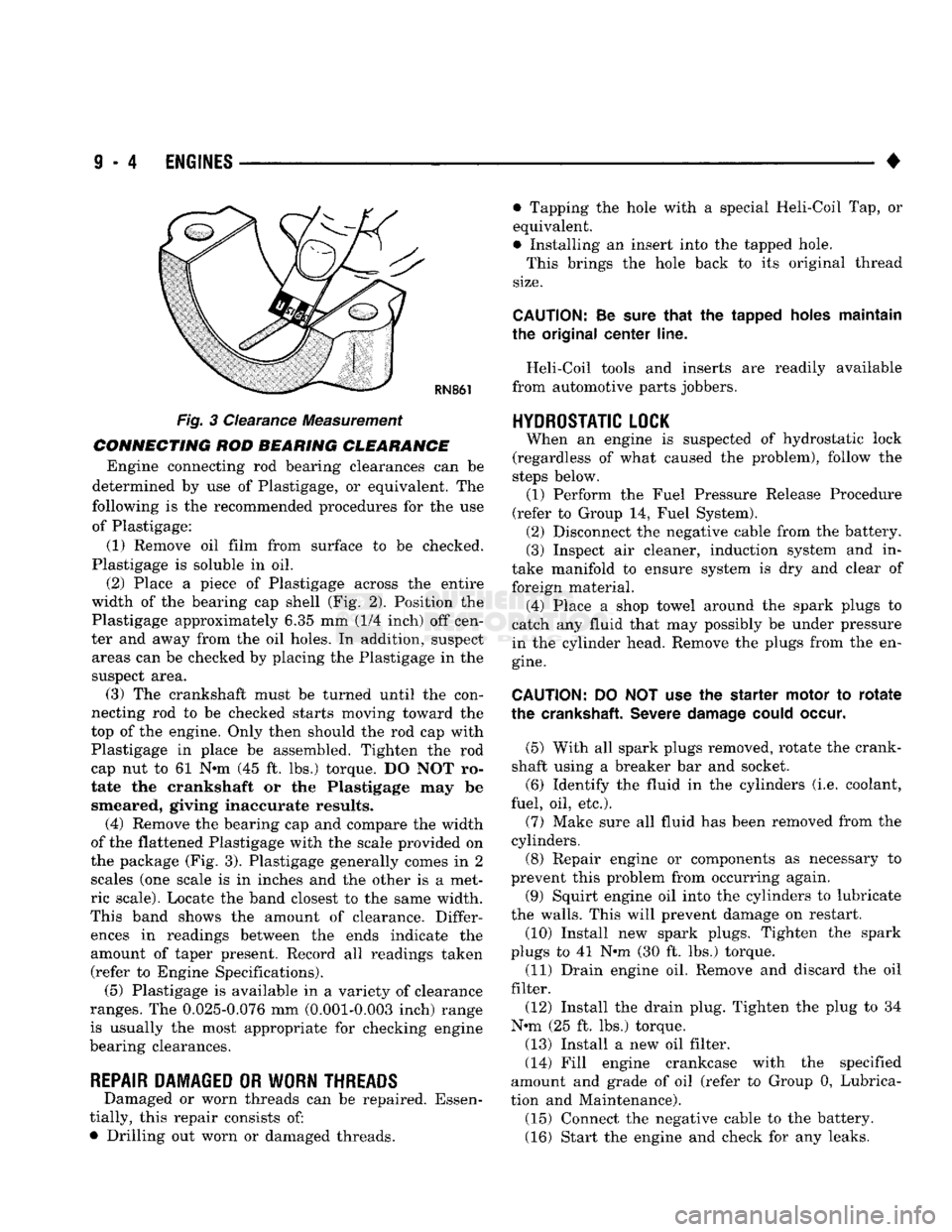
9
- 4 ENGINES
•
RN861
Fig. 3 Clearance Measurement
CONNECTING ROD BEARING CLEARANCE Engine connecting rod bearing clearances can be
determined by use of Plastigage, or equivalent. The
following is the recommended procedures for the use of Plastigage:
(1) Remove oil film from surface to be checked.
Plastigage is soluble in oil.
(2) Place a piece of Plastigage across the entire
width of the bearing cap shell (Fig. 2). Position the
Plastigage approximately 6.35 mm (1/4 inch) off cen
ter and away from the oil holes. In addition, suspect areas can be checked by placing the Plastigage in the
suspect area. (3) The crankshaft must be turned until the con
necting rod to be checked starts moving toward the
top of the engine. Only then should the rod cap with
Plastigage in place be assembled. Tighten the rod
cap nut to 61 Nnn (45 ft. lbs.) torque. DO NOT ro
tate the crankshaft or the Plastigage may be smeared, giving inaccurate results. (4) Remove the bearing cap and compare the width
of the flattened Plastigage with the scale provided on
the package (Fig. 3). Plastigage generally comes in 2 scales (one scale is in inches and the other is a met
ric scale). Locate the band closest to the same width.
This band shows the amount of clearance. Differ ences in readings between the ends indicate the
amount of taper present. Record all readings taken (refer to Engine Specifications). (5) Plastigage is available in a variety of clearance
ranges. The 0.025-0.076 mm (0.001-0.003 inch) range
is usually the most appropriate for checking engine
bearing clearances.
REPAIR DAMAGED OR WORN THREADS Damaged or worn threads can be repaired. Essen
tially, this repair consists of:
• Drilling out worn or damaged threads. • Tapping the hole with a special Heli-Coil Tap, or
equivalent.
• Installing an insert into the tapped hole.
This brings the hole back to its original thread
size.
CAUTION:
Be
sure
that
the tapped holes maintain
the original
center
line.
Heli-Coil tools and inserts are readily available
from automotive parts jobbers.
HYDROSTATIC
LOCK
When an engine is suspected of hydrostatic lock
(regardless of what caused the problem), follow the
steps below. (1) Perform the Fuel Pressure Release Procedure
(refer to Group 14, Fuel System). (2) Disconnect the negative cable from the battery.
(3) Inspect air cleaner, induction system and in
take manifold to ensure system is dry and clear of
foreign material. (4) Place a shop towel around the spark plugs to
catch any fluid that may possibly be under pressure
in the cylinder head. Remove the plugs from the en
gine.
CAUTION:
DO NOT use the starter motor to
rotate
the
crankshaft.
Severe
damage
could
occur.
(5) With all spark plugs removed, rotate the crank
shaft using a breaker bar and socket.
(6) Identify the fluid in the cylinders (i.e. coolant,
fuel, oil, etc.).
(7) Make sure all fluid has been removed from the
cylinders. (8) Repair engine or components as necessary to
prevent this problem from occurring again.
(9) Squirt engine oil into the cylinders to lubricate
the walls. This will prevent damage on restart.
(10) Install new spark plugs. Tighten the spark
plugs to 41 N#m (30 ft. lbs.) torque. (11) Drain engine oil. Remove and discard the oil
filter.
(12) Install the drain plug. Tighten the plug to 34
N-m (25 ft. lbs.) torque.
(13) Install a new oil filter.
(14) Fill engine crankcase with the specified
amount and grade of oil (refer to Group 0, Lubrica
tion and Maintenance). (15) Connect the negative cable to the battery.
(16) Start the engine and check for any leaks.
Page 610 of 1502
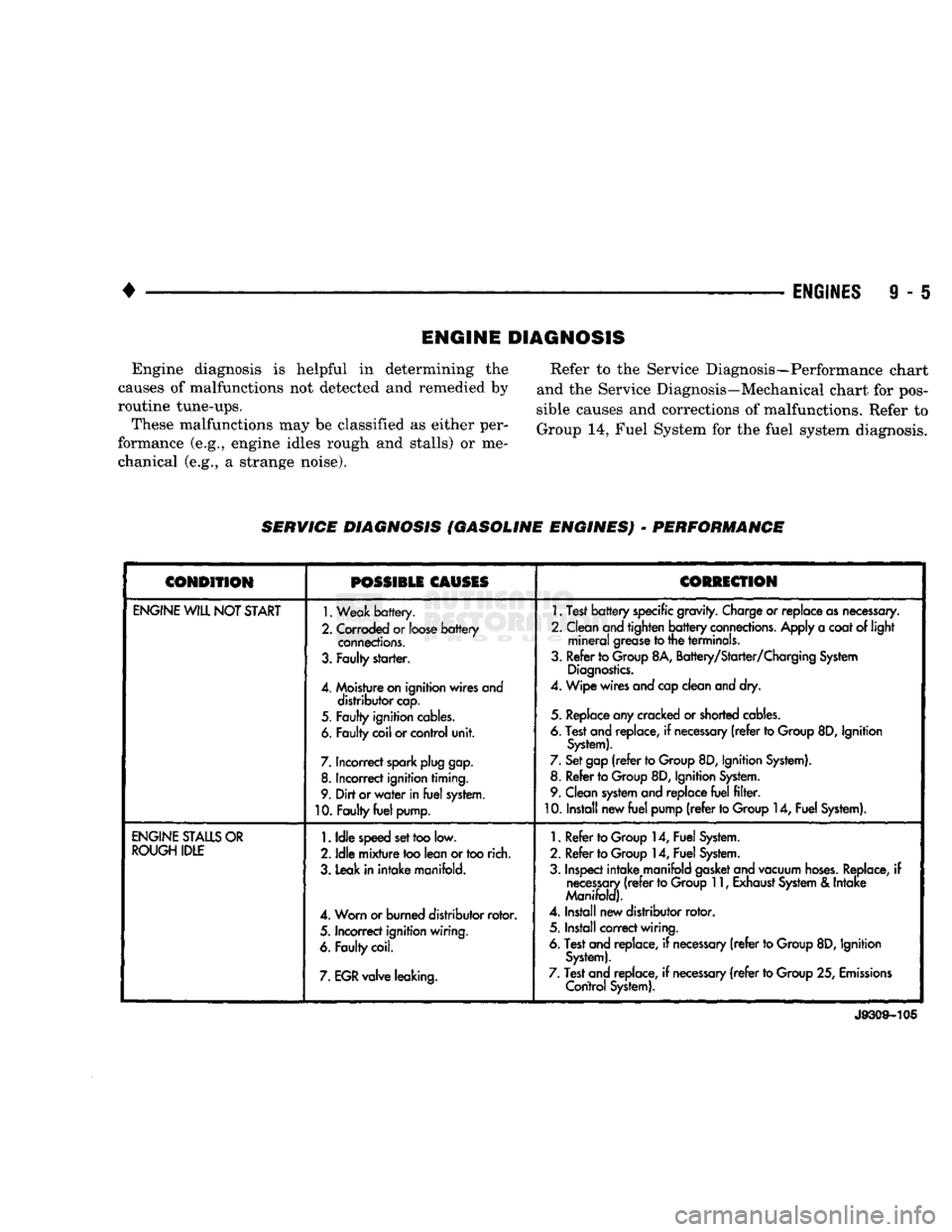
•
ENGINES
9 - S
ENGINE
DIAGNOSIS
Engine diagnosis is helpful in determining the
causes of malfunctions not detected and remedied by
routine tune-ups. These malfunctions may be classified as either per
formance (e.g., engine idles rough and stalls) or me chanical (e.g., a strange noise). Refer to the Service Diagnosis—Performance chart
and the Service Diagnosis—Mechanical chart for pos
sible causes and corrections of malfunctions. Refer to
Group 14, Fuel System for the fuel system diagnosis.
SERWIGE DIAGNOSIS (GASOLINE ENGINES)
-
PERFORMANCE
CONDITION
POSSIBLE
CAUSES
CORRECTION
ENGINE
WILL
NOT
START
1.
Weak
battery.
2.
Corroded
or
loose
battery
connections.
3.
Faulty
starter.
4.
Moisture
on
ignition wires and distributor
cap.
5.
Faulty
ignition
cables.
6.
Faulty
coil
or
control
unit.
7.
Incorrect
spark
plug
gap.
8.
Incorrect
ignition timing.
9.
Dirt
or
water
in
fuel
system.
10.
Faulty
fuel
pump.
1.
Test
battery
specific
gravity.
Charge
or
replace
as
necessary.
2. Clean
and
tighten
battery
connections.
Apply
a
coat
of light
mineral
grease
to
the terminals.
3. Refer to
Group
8A, Battery/Starter/Charging
System
Diagnostics.
4. Wipe
wires
and
cap
clean
and
dry.
5.
Replace
any
cracked
or
shorted
cables.
6.
Test
and
replace,
if
necessary
(refer
to
Group
8D,
Ignition
System).
7.
Set
gap
(refer
to
Group
8D, Ignition
System).
8. Refer to
Group
8D, Ignition
System.
9. Clean
system
and
replace
fuel
filter.
10. Install new
fuel
pump
(refer
to
Group
14,
Fuel
System).
ENGINE
STALLS
OR
ROUGH
IDLE
1.
Idle
speed
set
too
low.
2.
Idle
mixture
too
lean
or
too
rich.
3. Leak in
intake
manifold.
4. Worn or burned distributor
rotor.
5.
Incorrect
ignition wiring.
6.
Faulty
coil.
7.
EGR
valve leaking.
1.
Refer to
Group
14,
Fuel
System.
2. Refer to
Group
14,
Fuel
System.
3.
Inspect
intake
manifold
gasket
and
vacuum
hoses.
Replace,
if
necessary
(refer
to
Group
11,
Exhaust
System
&
Intake
Manifold).
4.
Install new distributor
rotor.
5. Install
correct
wiring.
6.
Test
and
replace,
if
necessary
(refer
to
Group
8D,
Ignition
System).
7.
Test
and
replace,
if
necessary
(refer
to
Group
25,
Emissions
Control
System).
J9309-105